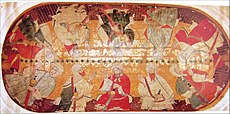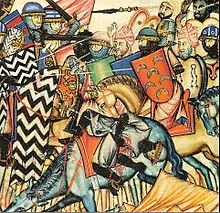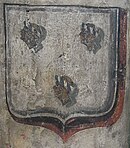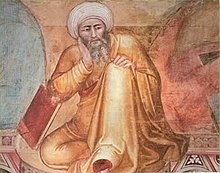Moors
Castillian ambassadors attempting to convince Moorish Almohad king Abu Hafs Umar al-Murtada to join their alliance (contemporary depiction from the Cantigas de Santa María)
Moors are not a distinct or self-defined people,[4] and the 1911 Encyclopædia Britannica observed that "The term 'Moors' has no real ethnological value."[5] Europeans of the Middle Ages and the early modern period variously applied the name to Arabs, North African Berbers, and Muslim Europeans.[6]
The term has also been used in Europe in a broader, somewhat derogatory sense to refer to Muslims in general,[7] especially those of Arab or Berber descent, whether living in Spain or North Africa.[8] During the colonial era, the Portuguese introduced the names "Ceylon Moors" and "Indian Moors" in Sri Lanka, and the Bengali Muslims were also called Moors.[9] In the Philippines, the longstanding Muslim community, which predates the arrival of the Spanish, now self-identifies as the "Moro people", an exonym introduced by Spanish colonizers due to their Muslim faith.
In 711, troops mostly formed by Moors from northern Africa led the Umayyad conquest of Hispania. The Iberian peninsula then came to be known in Classical Arabic as al-Andalus, which at its peak included most of Septimania and modern-day Spain and Portugal.
In 827, the Moors occupied Mazara on Sicily, developing it as a port.[10] They eventually consolidated the rest of the island and some of southern Italy. Differences in religion and culture led to a centuries-long conflict with the Christian kingdoms of Europe, which tried to reclaim control of Muslim areas; this conflict was referred to as the Reconquista. In 1224 the Muslims were expelled from Sicily to the settlement of Lucera, which was destroyed by European Christians in 1300.
The fall of Granada in 1492 marked the end of Muslim rule in Iberia, although a Muslim minority persisted until their expulsion in 1609.[11]
Contents
Name
Etymology
During the classical period, the Romans interacted with, and later conquered, parts of Mauretania, a state that covered modern northern Morocco, western Algeria, and the Spanish cities Ceuta and Melilla.[12] The Berber tribes of the region were noted in the Classics as Mauri, which was subsequently rendered as "Moors" in English and in related variations in other European languages.[13] Mauri (Μαῦροι) is recorded as the native name by Strabo in the early 1st century. This appellation was also adopted into Latin, whereas the Greek name for the tribe was Maurusii (Ancient Greek: Μαυρούσιοι).[14] The Moors were also mentioned by Tacitus as having revolted against the Roman Empire in 24 AD.[15]During the Latin Middle Ages, Mauri was used to refer to Berbers and Arabs in the coastal regions of Northwest Africa. [16] The 16th century scholar Leo Africanus (c. 1494–1554) identified the Moors (Mauri) as the native Berber inhabitants of the former Roman Africa Province (Roman Africans). He described Moors as one of five main population groups on the continent alongside Egyptians, Abyssinians (Abassins), Arabians and Cafri (Cafates).[1]
The term was commonly used as a racial designation for dark-skinned or black peoples, as with its use in English, seen as early as the fourteenth century.[16]
Modern meanings
In medieval Romance languages, variations of the Latin word for the Moors (for instance, Italian and Spanish: moro, French: maure, Portuguese: mouro, Romanian: maur) developed different applications and connotations. The term initially denoted a specific Berber people in western Libya, but the name acquired more general meaning during the medieval period, associated with "Muslim", similar to associations with "Saracens". During the context of the Crusades and the Reconquista, the term Moors included the derogatory suggestion of "infidels".Apart from these historic associations and context, Moor and Moorish designate a specific ethnic group speaking Hassaniya Arabic. They inhabit Mauritania and parts of Algeria, Western Sahara, Tunisia, Morocco, Niger, and Mali. In Niger and Mali, these peoples are also known as the Azawagh Arabs, after the Azawagh region of the Sahara.[17]
The authoritative dictionary of the Spanish language does not list any derogatory meaning for the word moro, a term generally referring to people of Maghrebian origin in particular or Muslims in general.[18] Some authors have pointed out that in modern colloquial Spanish use of the term moro is derogatory for Moroccans in particular[19][20][21][22][23] and Muslims in general.
In modern, colloquial Portuguese, the term Mouro was primarily used as a designation for North Africans and secondarily as a derogatory and ironic term by northern Portuguese to refer to the inhabitants of the southern parts of the country (Lisbon, Alentejo, and Algarve). However, this designation has gained more acceptance in the south.
In the Philippines, a former Spanish colony, many modern Filipinos call the large, local Muslim minority concentrated in Mindanao and other southern islands Moros. The word is a catch-all term, as Moro may come from several distinct ethno-linguistic groups such as the Maranao people. The term was introduced by Spanish colonisers, and has since been appropriated by Filipino Muslims as an endonym, with many self-identifying as members of the Bangsamoro "Moro Nation".
Moreno can mean dark-skinned in Spain, Portugal, Brazil, and the Philippines. Also in Spanish, morapio is a humorous name for "wine", especially that which has not been "baptized" or mixed with water, i.e., pure unadulterated wine. Among Spanish speakers, moro came to have a broader meaning, applied to both Filipino Moros from Mindanao, and the moriscos of Granada. Moro refers to all things dark, as in "Moor", moreno, etc. It was also used as a nickname; for instance, the Milanese Duke Ludovico Sforza was called Il Moro because of his dark complexion.[24]
In Portugal, mouro (feminine, moura) may refer to supernatural beings known as enchanted moura, where "moor" implies 'alien' and 'non-Christian'. These beings were siren-like fairies with golden or reddish hair and a fair face. They were believed to have magical properties.[25] From this root, the name moor is applied to unbaptized children, meaning not Christian.[26][27] In Basque, mairu means moor and also refers to a mythical people.[28]
Within the context of Portuguese colonization, in Sri Lanka (Portuguese Ceylon), Muslims of Arab origin are called Ceylon Moors, not to be confused with "Indian Moors" of Sri Lanka (see Sri Lankan Moors). Sri Lankan Moors (a combination of "Ceylon Moors" and "Indian Moors") make up 12% of the population. The Ceylon Moors (unlike the Indian Moors) are descendants of Arab traders who settled there in the mid-6th century. When the Portuguese arrived in the early 16th century, they labelled all the Muslims in the island as Moors as they saw some of them resembling the Moors in North Africa. The Sri Lankan government continues to identify the Muslims in Sri Lanka as "Sri Lankan Moors", sub-categorised into "Ceylon Moors" and "Indian Moors".[29]
The Goan Muslims — a minority community who follow Islam in the western Indian coastal state of Goa — are commonly referred as Moir (Konkani: मैर) by Goan Catholics and Hindus.[a] Moir is derived from the Portuguese word mouro (Moor).
Moors of the Maghreb
The Great Mosque of Kairouan was founded by the Arab general Uqba ibn Nafi in 670 during the Islamic conquest, to provide a place of worship for recently converted or immigrating Muslims.
Although a Christian and pagan Berber rebellion pushed out the Arabs temporarily, the Romanized urban population preferred the Arabs to the Berbers and welcomed a renewed and final conquest that left northern Africa in Muslim hands by 698. Over the next decades, the Berber and urban populations of northern Africa gradually converted to Islam, although for separate reasons.[31] The Arabic language was also adopted. Initially, the Arabs required only vassalage from the local inhabitants rather than assimilation, a process which took a considerable time.[31] The groups that inhabited the Maghreb following this process became known collectively as Moors. Although the Berbers would later expel the Arabs from the Maghreb and form temporarily independent states, that effort failed to dislodge the usage of the collective term.
Moors of Iberia
Depiction of the Moors in Iberia, from The Cantigas de Santa Maria
The Maghreb fell into a civil war in 739 that lasted until 743 known as the Berber Revolt. The Berbers revolted against the Umayyads, putting an end to Eastern dominion over the Maghreb. Despite racial tensions, Arabs and Berbers intermarried frequently. A few years later, the Eastern branch of the Umayyad dynasty was dethroned by the Abbasids and the Umayyad Caliphate overthrown in the Abbasid revolution (746-750). Abd al-Rahman I, who was of Arab-Berber lineage, managed to evade the Abbasids and flee to the Maghreb and then Iberia, where he founded the Emirate of Córdoba and the Andalusian branch of the Umayyad dynasty. The Moors ruled northern Africa and Al-Andalus for several centuries thereafter.[35] Ibn Hazm, the polymath, mentions that many of the Caliphs in the Umayyad Caliphate and the Caliphate of Córdoba were blond and had light eyes.[36] Ibn Hazm mentions that he preferred blondes, and notes that there was much interest in blondes in al-Andalus amongst the rulers and regular Muslims:
All the Caliphs of the Banu Marwan (God have mercy on their souls!), and especially the sons of al-Nasir, were without variation or exception disposed by nature to prefer blondes. I have myself seen them, and known others who had seen their forebears, from the days of al-Nasir's reign down to the present day; every one of them has been fair-haired, taking after their mothers, so that this has become a hereditary trait with them; all but Sulaiman al-Zafir (God have mercy on him!), whom I remember to have had black ringlets and a black beard. As for al-Nasir and al-Hakam al-Mustansir (may God be pleased with them!), I have been informed by my late father, the vizier, as well as by others, that both of them were blond and blue-eyed. The same is true of Hisham al-Mu'aiyad, Muhammad al-Mahdi, and `Abd al-Rahman al-Murtada (may God be merciful to them all!); I saw them myself many times, and had the honour of being received by them, and I remarked that they all had fair hair and blue eyes.[37]
Moorish army (right) of Almanzor during the Reconquista Battle of San Esteban de Gormaz, from Cantigas de Alfonso X el Sabio
The Caliphate of Córdoba collapsed in 1031 and the Islamic territory in Iberia fell under the rule of the Almohad Caliphate in 1153. This second stage was guided by a version of Islam that left behind the more tolerant practices of the past.[40] Al-Andalus broke up into a number of taifas (fiefs), which were partly consolidated under the Caliphate of Córdoba.
A Moorish warrior embraces his Castilian ally during the Mudéjar revolt of 1264–66, taken from The Cantigas de Santa María
The Moorish Kingdom of Granada continued for three more centuries in southern Iberia. On 2 January 1492, the leader of the last Muslim stronghold in Granada surrendered to the armies of a recently united Christian Spain (after the marriage of Ferdinand II of Aragón and Isabella I of Castile, the "Catholic Monarchs"). The Moorish inhabitants received no military aid or rescue from other Muslim nations.[41] The remaining Jews were also forced to leave Spain, convert to Roman Catholic Christianity, or be killed for refusing to do so. In 1480, to exert social and religious control, Isabella and Ferdinand agreed to allow the Inquisition in Spain. The Muslim population of Granada rebelled in 1499. The revolt lasted until early 1501, giving the Castilian authorities an excuse to void the terms of the Treaty of Granada (1491). In 1501, Castilian authorities delivered an ultimatum to the Muslims of Granada: they could either convert to Christianity or be expelled.
Court of the lions in the Alhambra, a Moorish palace built in the 14th century in Granada, Spain
Some Muslims converted to Christianity and remained permanently in Iberia. This is indicated by a "high mean proportion of ancestry from North African (10.6%)" that "attests to a high level of religious conversion (whether voluntary or enforced), driven by historical episodes of social and religious intolerance, that ultimately led to the integration of descendants."[43][44] According to historian Richard A. Fletcher,[45] "the number of Arabs who settled in Iberia was very small. 'Moorish' Iberia does at least have the merit of reminding us that the bulk of the invaders and settlers were Moors, i.e., Berbers from Algeria and Morocco."
In the meantime, Spanish and Portuguese expeditions westward from the New World spread Christianity to India, the Malay peninsula, Indonesia, and the Philippines. By 1521, the ships of Magellan had reached that island archipelago, which they named Las Islas Filipinas, after Philip II of Spain. In Mindanao, the Spaniards named the kris-bearing people as Moros or 'Moors'. Today this ethnic group in Mindanao, who are generally Filipino Muslim, are called "Moros".
Moors of Sicily
Muslim musicians at the court of the Norman King Roger II of Sicily
In 1038, a Byzantine army under George Maniakes crossed the strait of Messina. This army included a corps of Normans that saved the situation in the first clash against the Muslims from Messina. After another decisive victory in the summer of 1040, Maniaces halted his march to lay siege to Syracuse. Despite his success, Maniaces was removed from his position, and the subsequent Muslim counter-offensive reconquered all the cities captured by the Byzantines.
The Norman Robert Guiscard, son of Tancred, invaded Sicily in 1060. The island was split between three Arab emirs, and the Christian population in many parts of the island rose up against the ruling Muslims. One year later, Messina fell, and in 1072 Palermo was taken by the Normans. The loss of the cities, each with a splendid harbor, dealt a severe blow to Muslim power on the island. Eventually all of Sicily was taken. In 1091, Noto in the southern tip of Sicily and the island of Malta, the last Arab strongholds, fell to the Christians. Islamic authors noted the tolerance of the Norman kings of Sicily. Ali ibn al-Athir wrote: "They [the Muslims] were treated kindly, and they were protected, even against the Franks. Because of that, they had great love for King Roger."[46]
The Muslim problem characterized Hohenstaufen rule in Sicily under Holy Roman Emperors Henry VI and his son, Frederick II. Many repressive measures were introduced by Frederick II to please the popes, who were intolerant of Islam in the heart of Christendom. This resulted in a rebellion by Sicilian Muslims, which in turn triggered organized resistance and systematic reprisals and marked the final chapter of Islam in Sicily. The complete eviction of Muslims and the annihilation of Islam in Sicily was completed by the late 1240s when the final deportations to Lucera took place.
Architecture
Interior of the Mosque–Cathedral of Córdoba
In heraldry
Coat of arms of Aragon with Moors' heads.
Arms of the wealthy Bristol merchant and shipper William II Canynges (d.1474), as depicted on his canopied tomb in St Mary Redcliffe Church, showing the couped heads of three Moors wreathed at the temples
Flag of the Emirate of Granada of the Arab Nasrid dynasty, was the last Muslim kingdom of al-Andalus
The use of Moors (and particularly their heads) as a heraldic symbol has been deprecated in modern North America.[54] For example, the College of Arms of the Society for Creative Anachronism urges applicants to use them delicately to avoid causing offence.[55]
Population
Moors on the North African coast, as depicted in Britain in 1739
As a large and diffuse ethnic group, the Moors consisted mostly of Berbers from Morocco and Western Algeria, sub-Saharan Africans from Mauritania, Northern Senegal, and Western Mali, Arab Bedouins, and Arab elite mostly from Yemen and Syria. Most writings on Moors applied darkness of skin as a trait for any and every Muslim invader of Europe.[58]
In popular culture
- The title character in William Shakespeare's play Othello, and the derived title character in Verdi's opera Otello, is a Moor. The character has been played by various thespians in different forms of entertainment. A less well-known Moorish character, Aaron, appears in Shakespeare’s earlier tragedy Titus Andronicus.
- Morgan Freeman's character Azeem in the 1991 film Robin Hood: Prince of Thieves is a Moor who Robin Hood saves from prison.
- The 2009 documentary film Journey to Mecca follows the travels of the Moorish explorer Ibn Battuta from his native country of Morocco to Mecca for the Hajj in 1325.
Notable Moors
Averroes, a Moorish polymath, was the founder of the Averroism school of philosophy, and influential in the rise of secular thought in Western Europe. Painted by Andrea Bonaiuto in 14th century
- Tariq ibn Ziyad, Moorish general who defeated the Visigoths and conquered Hispania in 711.
- Abd ar-Rahman I, founder of the Umayyad Emirate of Córdoba in 756; along with its succeeding Caliphate of Córdoba, the dynasty ruled Islamic Iberia for three centuries.
- Ibn al-Qūṭiyya, Andalusian historian and grammarian.
- Yahya al-Laithi, Andalusian scholar who introduced the Maliki school of jurisprudence in Al-Andalus.
- Abbas ibn Firnas, 810–887, Berber inventor and aviator who invented an early parachute and made the first attempt at controlled flight with a hang glider.
- Maslama al-Majriti, died 1007, Andalusian writer believed to have been the author of the Encyclopedia of the Brethren of Purity and the Picatrix.
- Al-Zahrawi (Abulcasis), Andalusian physician and surgeon who established the discipline of surgery as a profession with his Al-Tasrif in 1000.
- Said Al-Andalusi, 1029–1070, Andalusian Qadi, historian, philosopher, mathematician and astronomer.
- Abū Ishāq Ibrāhīm al-Zarqālī (Arzachel), 1029–1087, Andalusian astronomer and engineer who developed the equatorium and universal (latitude-independent) astrolabe and compiled a Zij later used as a basis for the Tables of Toledo.
- Artephius, circa 1126, Andalusian scientist known as the author of numerous works of Alchemical texts, now extant only in Latin.
- Ibn Bajjah (Avempace), died 1138, Andalusian physicist and polymath whose theory of motion, including the concept of a reaction force, influenced the development of classical mechanics.
- Ibn Zuhr (Avenzoar), 1091–1161, Andalusian physician and polymath who discovered the existence of parasites and pioneered experimental surgery.
- Muhammad al-Idrisi, circa 1100–1166, Moorish geographer and polymath who drew the Tabula Rogeriana, the most accurate world map in pre-modern times.
- Ibn Tufail, circa 1105–1185, Arabic writer and polymath who wrote Hayy ibn Yaqdhan, the first philosophical novel.
- Averroes (Ibn Rushd), 1126–1198, classical Islamic philosopher and polymath who wrote The Incoherence of the Incoherence and the most extensive Aristotelian commentaries, and established the school of Averroism.
- Ibn al-Baitar, died 1248, Andalusian botanist and pharmacist who compiled the most extensive pharmacopoeia and botanical compilation in pre-modern times.
- Ibn Khaldun, a pioneer of the social sciences and forerunner of sociology, historiography and economics, who wrote the Muqaddimah in 1377.
- Abū al-Hasan ibn Alī al-Qalasādī, 1412–1486, Moorish mathematician who took the first steps toward the introduction of algebraic symbolism.
- Leo Africanus, 1494–1554, Andalusian geographer, author and diplomat, who was captured by Spanish pirates and sold as a slave, but later baptized and freed.
- Estevanico, also referred to as "Stephen the Moor", was an explorer in the service of Spain of what is now the southwest of the United States.
- Ibn Battuta, an Islamic scholar and Moorish explorer who is generally considered one of the greatest travellers of all time.
- Ibn Hazm, a Moorish polymath who was considered one of the leading thinkers of the Muslim World and is widely acknowledged as the father of Comparative religion studies.
- Ibn Idhari, a Moorish historian who was the author of (Al-Bayan al-Mughrib) an important medieval text on the history of the Maghreb and Iberia.
See also
Notes
References
the Mauri -- or Moors -- were the Berbers
- Furtado, A. D. (1981). Goa, yesterday, to-day, tomorrow: an approach to various socio-economic and political issues in Goan life & re-interpretation of historical facts. Furtado's Enterprises. pp. 254 pages(page xviii).
Bibliography
- This section's bibliographical information is not fully provided. If you know these sources and can provide full information, you can help Wikipedia by completing it.
- Jan R. Carew. Rape of Paradise: Columbus and the birth of racism in America. Brooklyn, NY: A&B Books, c. 1994.
- David Brion Davis, "Slavery: White, Black, Muslim, Christian." New York Review of Books, vol. 48, #11 July 5, 2001. Do not have exact pages.
- Herodotus, The Histories
- Shomark O. Y. Keita, "Genetic Haplotypes in North Africa"
- Shomarka O. Y. Keita, "Studies of ancient crania from northern Africa." American Journal of Physical Anthropology 83:35-48 1990.
- Shomarka O. Y. Keita, "Further studies of crania from ancient northern Africa: an analysis of crania from First Dynasty Egyptian tombs, using multiple discriminant functions." American Journal of Physical Anthropology 87: 345-54, 1992.
- Shomarka O. Y. Keita, "Black Athena: race, Bernal and Snowden." Arethusa 26: 295-314, 1993.
- Bernard Lewis, "The Middle East".
- Bernard Lewis. The Muslim Discovery of Europe. NY: Norton, 1982. Also an article with the same title published in Bulletin of the School of Oriental and African Studies, University of London 20(1/3): 409-16, 1957.
- Bernard Lewis, "Race and Slavery in Islam".
- Stanley Lane-Poole, assisted by E. J. W. Gibb and Arthur Gilman. The Story of Turkey. NY: Putnam, 1888.
- Stanley Lane-Poole. The Story of the Barbary Corsairs. NY: Putnam,1890.
- Stanley Lane-Poole, The History of the Moors in Spain.
- J. A. (Joel Augustus) Rogers. Nature Knows No Color Line: research into the Negro ancestry in the white race. New York: 1952.
- Ronald Segal. Islam's Black Slaves: the other Black diaspora. NY: Farrar Straus Giroux, 2001.
- Ivan Van Sertima, ed. The Golden Age of the Moor. New Brunswick: Transaction Publishers, 1992. (Journal of African civilizations, vol. 11).
- Frank Snowden. Before Color Prejudice: the ancient view of blacks. Cambridge, Massachusetts: Harvard Univ. Press, 1983.
- Frank Snowden. Blacks in antiquity: Ethiopians in the Greco-Roman experience. Cambridge, Massachusetts: Belknap Press of Harvard University Press, 1970.
- David M. Goldenberg. The Curse of Ham: race and slavery in early Judaism, Christianity, and Islam. Princeton, NJ: Princeton University Press, c2003.
- Lucotte and Mercier, various genetic studies
- Eva Borreguero. "The Moors Are Coming, the Moors Are Coming! Encounters with Muslims in Contemporary Spain." p. 417-32 in Islam and Christian-Muslim Relations, 2006, vol. 17, no. 4, pp. 417–32.
External links
| Look up Moor or Moorish in Wiktionary, the free dictionary. |
| Wikiquote has quotations related to: Moors |
| Wikimedia Commons has media related to Moors. |
- "The Moors" by Ross Brann, published on New York University website.
- Secret Seal: On the image of the Blackamoor in European Heraldry, a PBS article.
- Encyclopedia - Britannica Online Encyclopedia (2006)
- Moors, Classic Encyclopedia (1911)
- Khalid Amine, Moroccan Shakespeare: From Moors to Moroccans. Paper presented at an International Conference Organized by The Postgraduate School of Critical Theory and Cultural Studies, University of Nottingham, and The British Council, Morocco, 12–14 April 2001.
- Africans in Medieval & Renaissance Art: The Moor's Head, Victoria and Albert Museum (n.d)
- Sean Cavazos-Kottke. Othello's Predecessors: Moors in Renaissance Popular Literature: (outline). Folger Shakespeare Library, 1998.
Languages
In one sense the word 'Moor' means Mohammedan Berbers and Arabs of North-western Africa, with some Syrians, who conquered most of Spain in the 8th century and dominated the country for hundreds of years.
In the year 827, Mazara was occupied by the Arabs, who made the city an important commercial harbour. That period was probably the most prosperous in the history of Mazara.














Comments
Post a Comment